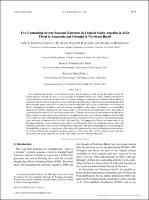| dc.contributor.author | Marengo, José A. | |
| dc.contributor.author | Alves, Lincoln M. | |
| dc.contributor.author | Soares, W.R. | |
| dc.contributor.author | Rodriguez, D.A. | |
| dc.contributor.author | Camargo, H. | |
| dc.contributor.author | Riveros, M.P. | |
| dc.contributor.author | Pabló, A.D. | |
| dc.coverage.spatial | Amazonia | |
| dc.date.accessioned | 2021-03-31T21:07:31Z | |
| dc.date.available | 2021-03-31T21:07:31Z | |
| dc.date.issued | 2013-11 | |
| dc.identifier.uri | https://hdl.handle.net/20.500.12542/859 | |
| dc.description.abstract | Two simultaneous extreme events affected tropical South America to the east of the Andes during the austral summer and fall of 2012: a severe drought in Northeast Brazil and intense rainfall and floods in Amazonia, both considered records for the last 50 years. Changes in atmospheric circulation and rainfall were consistent with the notion of an active role of colder-than-normal surface waters in the equatorial Pacific, with above-normal upward motion and rainfall in western Amazonia and increased subsidence over Northeast Brazil. Atmospheric circulation and soil moisture anomalies in the region contributed to an intensified transport of Atlantic moisture into the western part of Amazonia then turning southward to the southern Amazonia region, where the Chaco low was intensified. This was favored by the intensification of subtropical high pressure over the region, associated with an anomalously intense and northward-displaced Atlantic high over a relatively colder subtropical South Atlantic Ocean. This pattern observed in 2012 was not found during other wet years in Amazonia such as 1989, 1999, and 2009. This suggests La Niña as the main cause of the abundant rainfall in western Amazonia from October to December, with wet conditions starting earlier and remaining until March 2012, mostly in northwestern Amazonia. The anomalously high river levels during the following May–July were a consequence of this early and abundant rainy season during the previous summer. In Northeast Brazil, dry conditions started to appear in December 2011 in the northern sector and then extended to the entire region by the peak of the rainy season of February–May 2012. | es_PE |
| dc.format | application/pdf | es_PE |
| dc.language.iso | eng | es_PE |
| dc.publisher | American Meteorological Society | es_PE |
| dc.relation.ispartof | urn:issn:08948755 | |
| dc.relation.uri | https://journals.ametsoc.org/view/journals/clim/26/22/jcli-d-12-00642.1.xml | es_PE |
| dc.rights | info:eu-repo/semantics/openAccess | es_PE |
| dc.rights | Reconocimiento - No comercial - Sin obra derivada (CC BY-NC-ND) | es_PE |
| dc.rights.uri | https://creativecommons.org/licenses/by-nc-nd/4.0/ | es_PE |
| dc.source | Repositorio Institucional - SENAMHI | es_PE |
| dc.source | Servicio Nacional de Meteorología e Hidrología del Perú | es_PE |
| dc.subject | Floods | es_PE |
| dc.subject | Amazonia | es_PE |
| dc.subject | South America | es_PE |
| dc.subject | Rainfall | es_PE |
| dc.subject | Cambio Climático | es_PE |
| dc.subject | Extreme Event | es_PE |
| dc.subject | ENSO | es_PE |
| dc.title | Two Contrasting Severe Seasonal Extremes in Tropical South America in 2012: Flood in Amazonia and Drought in Northeast Brazil | es_PE |
| dc.type | info:eu-repo/semantics/article | es_PE |
| dc.description.peerreview | Por pares | es_PE |
| dc.identifier.doi | https://doi.org/10.1175/JCLI-D-12-00642.1 | |
| dc.identifier.journal | Journal of Climate | es_PE |
| dc.subject.ocde | https://purl.org/pe-repo/ocde/ford#1.05.10 | es_PE |
| dc.subject.sinia | inundaciones - Clima y Eventos Naturales | es_PE |
| dc.type.sinia | text/publicacion cientifica | es_PE |
| dc.identifier.url | https://hdl.handle.net/20.500.12542/859 | |
| dc.identifier.url | https://hdl.handle.net/20.500.12542/859 | |









